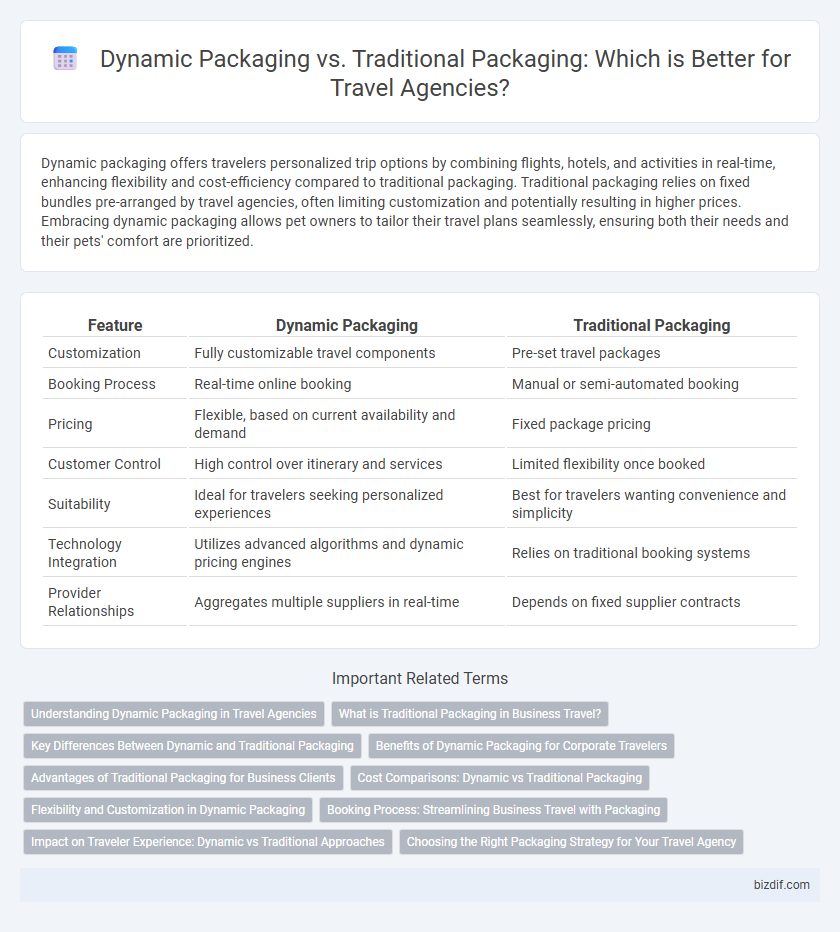Dynamic packaging offers travelers personalized trip options by combining flights, hotels, and activities in real-time, enhancing flexibility and cost-efficiency compared to traditional packaging. Traditional packaging relies on fixed bundles pre-arranged by travel agencies, often limiting customization and potentially resulting in higher prices. Embracing dynamic packaging allows pet owners to tailor their travel plans seamlessly, ensuring both their needs and their pets' comfort are prioritized.
Table of Comparison
| Feature | Dynamic Packaging | Traditional Packaging |
|---|---|---|
| Customization | Fully customizable travel components | Pre-set travel packages |
| Booking Process | Real-time online booking | Manual or semi-automated booking |
| Pricing | Flexible, based on current availability and demand | Fixed package pricing |
| Customer Control | High control over itinerary and services | Limited flexibility once booked |
| Suitability | Ideal for travelers seeking personalized experiences | Best for travelers wanting convenience and simplicity |
| Technology Integration | Utilizes advanced algorithms and dynamic pricing engines | Relies on traditional booking systems |
| Provider Relationships | Aggregates multiple suppliers in real-time | Depends on fixed supplier contracts |
Understanding Dynamic Packaging in Travel Agencies
Dynamic packaging in travel agencies allows customers to customize trips by selecting flights, hotels, and car rentals in real-time, providing flexibility and personalized travel experiences. Unlike traditional packaging, which offers pre-set bundles with fixed prices, dynamic packaging leverages live inventory and pricing data to optimize deals based on customer preferences and availability. This approach increases booking efficiency, enhances customer satisfaction, and empowers travel agencies to respond quickly to market changes.
What is Traditional Packaging in Business Travel?
Traditional packaging in business travel involves pre-arranged travel components such as flights, accommodations, and ground transportation combined into a fixed itinerary by the travel agency. This approach offers standardized options with set prices and limited customization but ensures streamlined booking processes and predictable costs. Travelers benefit from a simplified decision-making experience, although flexibility and personalization are often constrained compared to dynamic packaging solutions.
Key Differences Between Dynamic and Traditional Packaging
Dynamic packaging offers travelers customizable options by allowing them to combine flights, hotels, and activities in real-time, unlike traditional packaging, which provides fixed bundles with limited flexibility. This approach leverages advanced algorithms and real-time inventory access to optimize pricing and availability. Traditional packages often result in less personalized experiences and may not reflect the latest deals or preferences.
Benefits of Dynamic Packaging for Corporate Travelers
Dynamic packaging offers corporate travelers personalized and flexible options by combining flights, accommodation, and car rentals tailored to specific business needs. This approach reduces booking time and often results in cost savings through real-time price optimization and exclusive package deals. Enhanced convenience and seamless travel management improve productivity, making dynamic packaging a preferred choice for busy professionals.
Advantages of Traditional Packaging for Business Clients
Traditional packaging offers business clients greater predictability and control over travel arrangements, ensuring fixed costs and comprehensive service bundles that simplify budgeting. This method provides personalized support from travel agents, enhancing customer service through tailored solutions and immediate assistance. Established relationships with preferred suppliers often result in exclusive rates and added value, making traditional packaging a reliable choice for corporate travel management.
Cost Comparisons: Dynamic vs Traditional Packaging
Dynamic packaging offers cost savings by allowing travelers to customize their trips with flexible combinations of flights, hotels, and activities, often resulting in better prices than pre-set traditional packages. Traditional packaging tends to have fixed prices and limited options, which can lead to higher costs due to less supplier competition and reduced consumer choice. Leveraging real-time pricing and demand data, dynamic packaging optimizes travel budgets by delivering more value and affordability compared to conventional packaged deals.
Flexibility and Customization in Dynamic Packaging
Dynamic packaging offers unparalleled flexibility and customization by allowing travelers to mix and match flights, hotels, and activities in real time, tailored to their preferences and budgets. Unlike traditional packaging, which typically provides fixed bundles with limited options, dynamic packaging adapts to changing availability and personal travel needs, enhancing the overall user experience. This approach empowers customers to create unique itineraries that suit their specific interests and schedules, making it a preferred choice for modern travelers.
Booking Process: Streamlining Business Travel with Packaging
Dynamic packaging revolutionizes the booking process by allowing travel agencies to customize flights, accommodations, and car rentals in real-time, enhancing flexibility and personalization for business travelers. Traditional packaging relies on fixed combinations of travel services, often leading to limited choices and longer booking times. By streamlining dynamic packaging, agencies can reduce transaction costs and accelerate itinerary creation, ultimately optimizing efficiency in managing corporate travel needs.
Impact on Traveler Experience: Dynamic vs Traditional Approaches
Dynamic packaging enhances traveler experience by allowing real-time customization of flights, hotels, and activities, resulting in personalized and flexible itineraries tailored to individual preferences and budgets. Traditional packaging offers fixed bundles with predetermined options, which can limit traveler choice but often provides simplicity and cost savings through pre-negotiated rates. The flexibility of dynamic packaging leads to higher satisfaction and engagement by adapting instantly to traveler needs, whereas traditional packages appeal to those seeking straightforward planning and guaranteed deals.
Choosing the Right Packaging Strategy for Your Travel Agency
Dynamic packaging allows travel agencies to customize and bundle flights, hotels, and activities in real-time, offering personalized itineraries that boost customer satisfaction and increase revenue potential. Traditional packaging relies on pre-set bundles created by suppliers, providing less flexibility but simplified booking processes and predictable margins. Choosing the right packaging strategy depends on your agency's target market, technology capabilities, and desire for customization versus operational ease.
Dynamic packaging vs Traditional packaging Infographic

 bizdif.com
bizdif.com